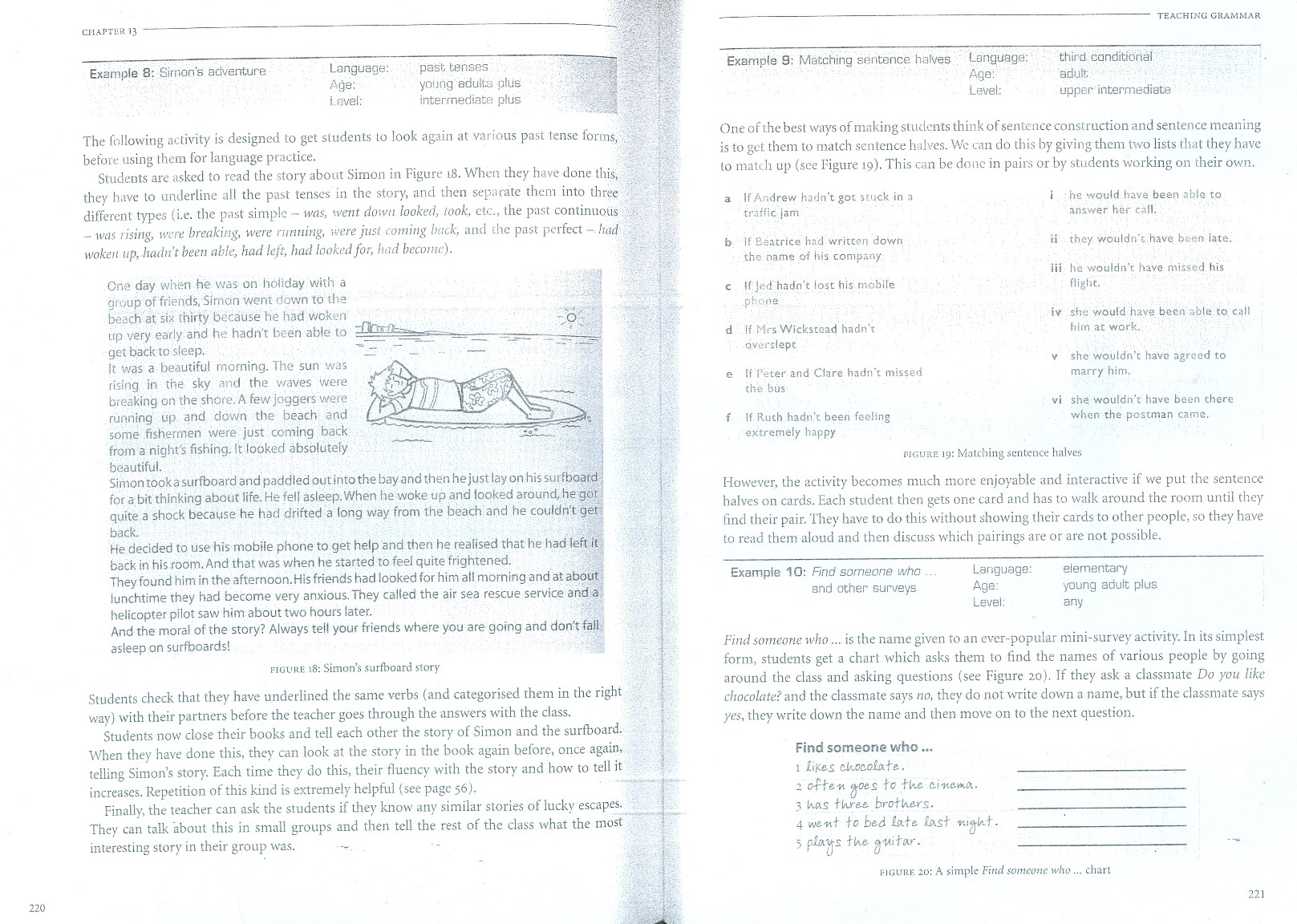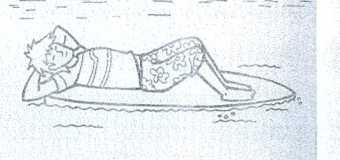0016

CIIAPTER 13
CIIAPTER 13

Example 8: Sirnon's aelventune Longuage: past tenses
Age: yniing adults plus
Level: intermediate plus
The fnllowing activity is designed lo get students lo Iook again at various past tense forms, before using them for language practłce.
Students are askcd to rcad the story about Simon in Figurt-18. When they have done tliis, thcy have lo underline ail the past tenses in the story, and then separate them into three different types (i.e. the past simplc - was, went down looked, iook, etc., the past continuous - was rising, were breaking, were running, were just coming bnck, and the past perfect - had woken up, hadn’tbeen ab!e, had left, had looked for, had become).
Cne day when he was on holiday willi a group of friends, Simon went down to the
beach at six tnirty because he had woken .
up very early and he hadn't been able to ....__ ' 1 * ’ .

get back to sleep.
it was a beautiful morning. The sun was rising in the sky and the waves were breaking on the shore.A few joggers were running up. and down the beach and some fishermen were just coming back frorn a night's fishing. It looked absolutely beautiful.
Simon took a surfboard and paddled out into the bay and then he just lay on his surfboard for a bit thinking about life. He fell asleep. When he woke up and looked around, he got quite a shock because he had drifted a long way from the beach and he couldn't get back.
He decided to use his mobile phone to get help and then he realised that he had left it back in his room. And that was when he started to feel quite frightened.
They found him in the afternoon.His friends had looked for him all morning and at about lunchtime they had become very anxious.They called the air sea rescue service and a helicopter pilot saw him about two hours later.
And the morał of the story? Always tell your friends where you are going and don't fali asleep on surfboards!
figurę 18: Simon’s surfboard stor)'
Students check that they have underlincd the same verbs (and categorised them in the right way) with their partners before the teacher goes through the answers with the class.
Students now close their books and tell each other the story of Simon and the surfboard. When they have done this, they can Iook at the story in the book again before, once again, telling Simon’s story. Each time they do this, their flucncy with the story and how to tell it increases. Repetition of this kind is extremely helpful (see page 56).
Finally, the teacher can ask the students if they know any similar stories of lucky escapes. They can talk about this in smali groups and then tell the rest of the class what the most interesting story in their group was. -
Example 9: Matching sentence halves Language: third canditional
Age: aduit.
Level; upper intermediate
One of the best ways of ma king students think of sentence construction and sentence meaning is to get them to match sentence halves. We can do this by gmng them two lists that they have to match up (see Figurę 19). This can be done in pairs or by students working on their own.
a If Ar.drew hadn’tgot stuck in a trafflc jam
b If Baatrice had written down the name of his company
c Ifijed hadn't lost his mobile phooe
d !f MrsWickscead hadnt óverslepc
e If Peter and Clare hadn’t missed the bus
f If Ruth hadnt been feeling extremely happy
i he wotild have been able to answer her cali.
ii they wouldn'c have been late.
iii he wouldn’t have missed his flight.
iv she would have been able to. cali him at work.
v she wouldn't have agreed to marry him.
vi she wouldmt have been there when the postman camc.
figurę 19: Matching sentence halves
However, the activity becomes much morę enjoyable and interactive if we put the sentence ha!ves on cards. Each student then gets one card and has to walk around the room until they find their pair. They have to do this without showing their cards to other people, so they have to read them aloud and then discuss which pairings are or are not possible. 2 1 3 4 5 6
elementary young aduit plus any
221
li yes aWoc.ob.Fe.. _
Example 10: Find someone who ... Lariguage:
and other surveys Age:
Level:
Find someone who... is the name given to an ever-popular mini-survey activitv. In its simplest form, students get a chart which aslcs them to find the names of various people by going around the class and asking ąuestions (see Figurę 20). If they ask a classmate Do you like chocolate? and the classmate says no, they do not write down a name, but if the classmate says yes, they write down the name and then move on to the next question.
Find someone who...
o-Fte-n g-oes to the c.i-nem.0.. _
tkree brot ker s. _
we-nt to bed b.te lust mftkt.
pla^s the g-nitar. _ .
figurę 20: A simple Find someone who... chart
Wyszukiwarka